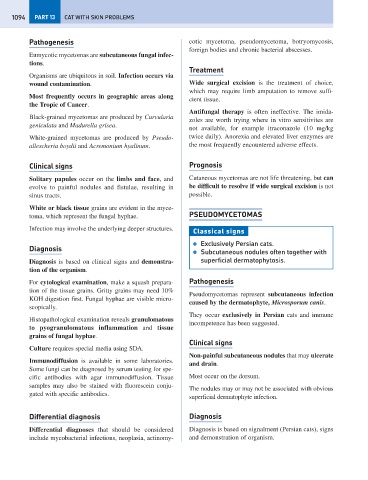Page 1102 - Problem-Based Feline Medicine
P. 1102
1094 PART 13 CAT WITH SKIN PROBLEMS
Pathogenesis cotic mycetoma, pseudomycetoma, botryomycosis,
foreign bodies and chronic bacterial abscesses.
Eumycotic mycetomas are subcutaneous fungal infec-
tions.
Treatment
Organisms are ubiquitous in soil. Infection occurs via
wound contamination. Wide surgical excision is the treatment of choice,
which may require limb amputation to remove suffi-
Most frequently occurs in geographic areas along
cient tissue.
the Tropic of Cancer.
Antifungal therapy is often ineffective. The imida-
Black-grained mycetomas are produced by Curvularia
zoles are worth trying where in vitro sensitivites are
geniculata and Madurella grisea.
not available, for example itraconazole (10 mg/kg
White-grained mycetomas are produced by Pseudo- twice daily). Anorexia and elevated liver enzymes are
allescheria boydii and Acremonium hyalinum. the most frequently encountered adverse effects.
Clinical signs Prognosis
Solitary papules occur on the limbs and face, and Cutaneous mycetomas are not life threatening, but can
evolve to painful nodules and fistulae, resulting in be difficult to resolve if wide surgical excision is not
sinus tracts. possible.
White or black tissue grains are evident in the myce-
toma, which represent the fungal hyphae. PSEUDOMYCETOMAS
Infection may involve the underlying deeper structures.
Classical signs
● Exclusively Persian cats.
Diagnosis
● Subcutaneous nodules often together with
Diagnosis is based on clinical signs and demonstra- superficial dermatophytosis.
tion of the organism.
For cytological examination, make a squash prepara- Pathogenesis
tion of the tissue grains. Gritty grains may need 10%
Pseudomycetomas represent subcutaneous infection
KOH digestion first. Fungal hyphae are visible micro-
caused by the dermatophyte, Microsporum canis.
scopically.
They occur exclusively in Persian cats and immune
Histopathological examination reveals granulomatous
incompetence has been suggested.
to pyogranulomatous inflammation and tissue
grains of fungal hyphae.
Clinical signs
Culture requires special media using SDA.
Non-painful subcutaneous nodules that may ulcerate
Immunodiffusion is available in some laboratories.
and drain.
Some fungi can be diagnosed by serum testing for spe-
cific antibodies with agar immunodiffusion. Tissue Most occur on the dorsum.
samples may also be stained with fluorescein conju-
The nodules may or may not be associated with obvious
gated with specific antibodies.
superficial dermatophyte infection.
Differential diagnosis Diagnosis
Differential diagnoses that should be considered Diagnosis is based on signalment (Persian cats), signs
include mycobacterial infections, neoplasia, actinomy- and demonstration of organism.

